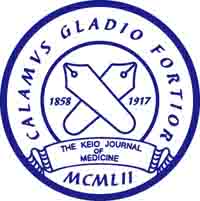[Published online The Keio Journal of Medicine Vol.68, 27-27, by J-STAGE]
<Title:> Toward the Mysteries of Sleep
<Author(s):> Masashi Yanagisawa
<Abstract:> Although sleep is a ubiquitous behavior in animal species with well-developed central nervous systems, many aspects in the neurobiology of sleep remain mysterious. Our discovery of orexin, a hypothalamic neuropeptide involved in the maintenance of wakefulness, has triggered an intensive research examining the exact role of the orexinergic and other neural pathways in the regulation of sleep/wakefulness. The orexin receptor antagonist suvorexant, which specifically block the endogenous waking system, has been approved as a new drug to treat insomnia. Also, since the sleep disorder narcolepsy-cataplexy is caused by orexin deficiency, orexin receptor agonists are expected to provide mechanistic therapy for narcolepsy; they will likely be also useful for treating excessive sleepiness due to other etiologies.Despite the fact that the executive neurocircuitry and neurochemistry for sleep/wake switching has been increasingly revealed in recent years, the mechanism for homeostatic regulation of sleep, as well as the neural substrate for “sleepiness” (sleep need), remains unknown. To crack open this black box, we have initiated a large-scale forward genetic screen of sleep/wake phenotype in mice based on true somnographic (EEG/EMG) measurements. We have so far screened >8,000 heterozygous ENU-mutagenized founders and established a number of pedigrees exhibiting heritable and specific sleep/wake abnormalities. By combining linkage analysis and the next-generation whole exome sequencing, we have molecularly identified and verified the causal mutation in several of these pedigrees. Biochemical and neurophysiological analyses of these mutations are underway. Since these dominant mutations cause strong phenotypic traits, we expect that the mutated genes will provide new insights into the elusive pathway regulating sleep/wakefulness. Indeed, through a systematic cross-comparison of the Sleepy mutants and sleep-deprived mice, we have recently found that the cumulative phosphorylation state of a specific set of mostly synaptic proteins may be the molecular substrate of sleep need.
<Keywords:>
<URL:> https://www.jstage.jst.go.jp/article/kjm/68/1/68_68-001-ABST/_html


![The Efficacy of Transcorneal Electrical Stimulation for the Treatment of Primary Open-angle Glaucoma: A Pilot Study [Published online Keio J Med, 67, 45-53, by J-STAGE]](http://kjm.pupu.jp/blog/wp-content/uploads/2018/09/2017-0015-OA-100x100.jpg)
![Seizure caused by Hypocalcemia as a Rare Manifestation in an Infant with Eosinophilic Gastroenteritis [Published online in advanced , by J-STAGE]](http://kjm.pupu.jp/blog/wp-content/uploads/2023/11/2023-0009-CR-100x100.jpg)
![Precision Cancer Medicine and Super-computing System [Published online Keio J Med, 66, 54-54, by J-STAGE]](http://kjm.pupu.jp/blog/wp-content/uploads/2017/09/66-003-ABST-100x100.jpg)
![<i>Listeria monocytogenes</i> Meningitis Complicating Rotavirus Gastroenteritis in an Immunocompetent Child [Published online in advanced , by J-STAGE]](http://kjm.pupu.jp/blog/wp-content/uploads/2017/04/2016-0007-CR-100x100.jpg)
![Pupil Dynamics-derived Sleep Stage Classification of a Head-fixed Mouse Using a Recurrent Neural Network [Published online in advanced , by J-STAGE]](http://kjm.pupu.jp/blog/wp-content/uploads/2023/02/2022-0020-OA-100x100.jpg)
![Headache Caused by Brain Metastases of Castration-resistant Prostate Cancer during Cabazitaxel Therapy [Published online Keio J Med, 66, 65-71, by J-STAGE]](http://kjm.pupu.jp/blog/wp-content/uploads/2017/12/2016-0014-CR-100x100.jpg)
![A Case of Renal Oncocytoma with Renal Venous Tumor Thrombus [Published online Keio J Med, 68, 39-41, by J-STAGE]](http://kjm.pupu.jp/blog/wp-content/uploads/2019/06/2017-0012-CR-100x100.jpg)
![Potential Universal Application of High-intensity Interval Training from Athletes and Sports Lovers to Patients [Published online Keio J Med, 66, 19-24, by J-STAGE]](http://kjm.pupu.jp/blog/wp-content/uploads/2017/06/2016-0006-IR-100x100.jpg)
![Chronological Spontaneous Partial Regression of a cerebral Arteriovenous Malformation- twenty-four Years Follow-up [Published online in advanced , by J-STAGE]](http://kjm.pupu.jp/blog/wp-content/uploads/2017/01/2016-0010-CR-100x100.jpg)
![Pupil Dynamics-derived Sleep Stage Classification of a Head-fixed Mouse Using a Recurrent Neural Network [Published online Keio J Med, 72, 44-59, by J-STAGE]](http://kjm.pupu.jp/blog/wp-content/uploads/2023/06/2022-0020-OA-100x100.jpg)